Standard Dual N-Back Working Memory Training
The aim of all working memory (WM) training programs is to expand working memory capacity. The most widely studied brain training exercise targeting WM capacity is the dual n-back task. The N-back task involves viewing a continuous stream of items (e.g., letters) and deciding whether each item matches the stimulus presented n stimuli back. In dual n-back training, a verbal and a visuospatial stream of items is presented simultaneously and item matches have to be detected for both types of information.
This dual task requires updating items in both the visual short term store and the verbal short term stores of working memory. The most well-known dual n-back task has been developed by Dr. Susanne Jaeggi and her colleagues back in 2008. We call this the ‘Standard’ dual n-back.
Known benefits of standard dual n-back working memory training
Working memory training results in widespread cognitive benefits (reviews: Morrison & Chein, 2011; Salminen, Strobach & Schubert, 2012):
- Increased performance on untrained measures of short term memory.
- Fluid intelligence (IQ)
- Multi-tasking – i.e. attentional selection between two sets of information associated with different tasks.
- Detaching attention from irrelevant items and attending to new relevant items.
- Episodic memory.
- Reading comprehension.
- Verbal learning and every day attention in older adults (60+).
- Reduced symptoms of ADHD.
- Improvements for multiple sclerosis – everyday memory, quality of life.
- Improvements for schizophrenia patients – everyday memory, quality of life.
- Improvements for frontal lobe stroke patients.
In general terms, the larger your working memory capacity or ‘mental workspace’, the greater your capacity for higher order cognition and thus academic and professional achievement. An example of this relationship is shown below.
Limitations of Standard Dual N-Back Training
Dual n-back training works. It improves your IQ and higher order executive cognition. The latest meta-review of all 24 dual n-back studies found a significant IQ increase from training and concludes:
“We urge that future studies move beyond attempts to answer the simple question of whether or not there is transfer [from dual n-back training to increases in IQ] and, instead, seek to explore the nature and extent of how these improved test scores may reflect true improvements in intelligence that can translate into practical, real-world settings.”
Jacky Au and colleagues, University of California, 2014
The most recent published commentary on the ‘n-back for IQ’ debate (Oct 2015) supports the conclusion that n-back training improves IQ.
But traditional (e.g. Jaeggi) dual n-back training has a number of critical limitations including the following:
- Small IQ gains. While there was a wide variation, the 2014 meta-review found only an average 4 point gain in IQ from dual n-back training. i3′s interference control training results in optimized IQ gains from your training – guaranteed to be 10-20 points.
- Counter-productive n-back strategies. The original Jaeggi dual n-back and its variants on the market do not prevent the use of strategies used to improve n-back levels without associated gains in actual working memory capacity – such as chunking, attention blinking and playing the odds. i3′s second generation (2G) brain training has been designed to minimize these strategies.
- Low Motivation. N-back training is very challenging and traditional n-back apps on the market have a high drop-out rate because they are poorly designed for motivation. i3 has been designed for maximum user-friendliness and motivation, effectively delivering the training you need while maintaining motivation.
2G N-Back Training
1. Interference Control
Recent research reveals that interference control is critical to high levels of fluid intelligence and working memory. Interference control is a kind of attention control – the ability to filter out distracting information or suppress irrelevant habits or responses, when faced with cognitive challenges.
What is ‘interference’ in the dual n-back? You may have experienced interference in the standard dual n-back when the sequence of stimuli repeats itself before the target is presented. This creates confusion where you have to ‘repeat yourself’ to keep the series of items in memory.
Studies by Burgess, Gray, and fellow grad student Tod Braver (article 1) provide brain imaging evidence of a large overlap of intelligence and working memory brain circuitry when there is need for interference control on a task – but not otherwise.
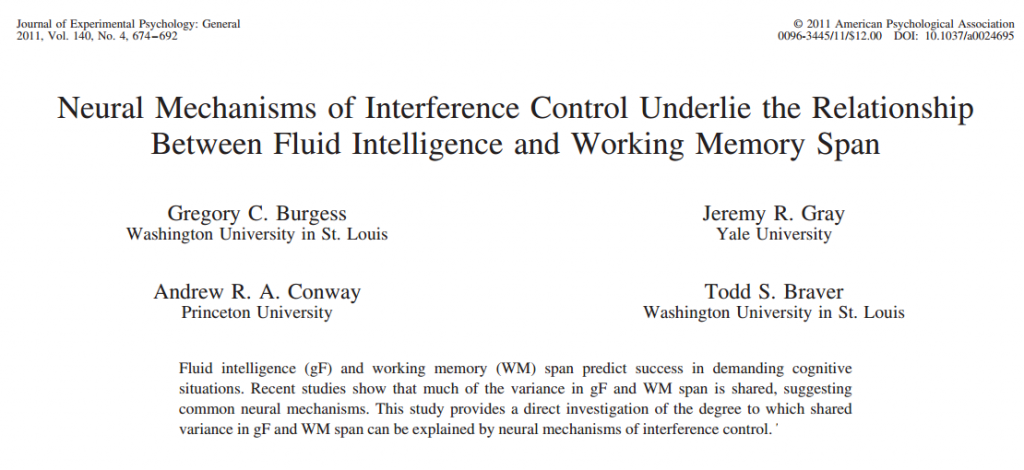
With i3 Mindware, the level of interference in 2G training can be systematically increased. This is not possible in standard dual n-back games.
[h2 align=’left’]2. Rhythm[/h2]
Electrical activity in the brain can be recorded using EEG electrodes on the scalp. Different types of brain waves (electrical oscillations) have been linked to sleep, navigation, cognition, attention, and can help diagnose a wide range of disorders including autism, schizophrenia and epilepsy. During standard dual n-back training, while our attention system keeps track of the updating letters and squares, sensory areas of the brain go into an electrical rhythm that matches the rhythm of the n-back letters and squares – for instance, every second. The n-back stimuli drive the cortex rhythmically (Lakatos et al., 2009).
The cortical brain rhythm helps process the stimuli, anticipating when the next sounds and squares will appear, and ‘binding’ the audio and visual information together in working memory.
How does this relate to real world cognition? Speech is rhythmic, our gestures are rhythmic, visual saccades (the moment to moment eye movements that we scan scenes or text with) are rhythmic. Our attention system works in these rhythms, resulting in periodic increases in excitability in anticipation of attended stimuli – making information processing more selective and efficient.
The speed and rhythm-breaks of the stimuli in 2G n-back can be systematically increased, which increases ‘cognitive load’ (the demands on working memory) which is expected to accelerate training gains and improve attentional flexibility.
3. Strategy Training
i3 Mindware’s second generation n-back training combines optional IQ test problem training with working memory n-back training, to harness a synergy between working memory and learning problem solving strategies.
Your working memory capacity is like a computer’s RAM power. Having more RAM allows you to process more information faster, but it doesn’t help you know what rules and strategies to apply to the information in order to get the right results. And it doesn’t help you solve problems unless you know the right strategies to apply to the problem. To learn how to do a mathematical calculation, you need to learn mathematical rules; to learn how to drive a car, you need to learn how to operate the car; to learn a second language, you need to apply grammatical rules. For overall cognitive performance, you need both cognitive capacity (a measure of the efficiency of your brain), as well as the right knowledge, know-how, rules, procedures and mental strategies.
Capacity-Strategy Synergy
A larger working memory capacity functions to allow for easier learning and application of mental mindware.
Working memory circuitry is located in the lateral prefrontal cortex. Activation in this area allows for the flexible application of a wider range of novel strategies and rules [reference], overcoming automatic responses. These new rules – with practice – are then more effectively encoded in more anterior (to the front of the head) prefrontal areas [reference]. This is shown in the ‘Capacity-Strategy’ infographic below.
For the scientific basis of this setting with references click here.


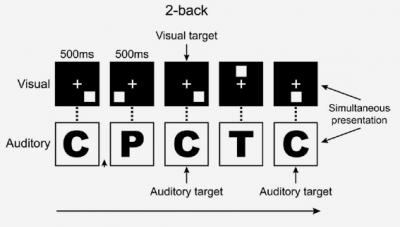
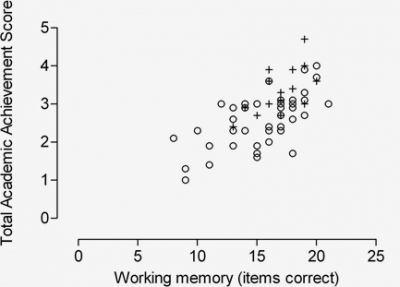
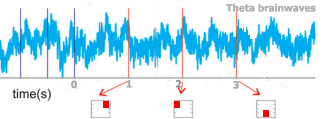
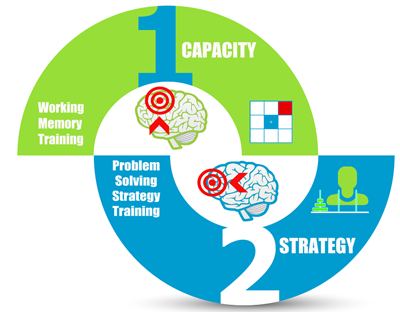
No comments yet.